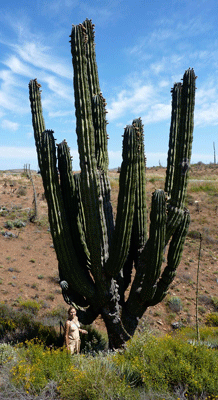Voyage of Kiri writer Kristian Beadle is amazed by the lushness of a Mexico desert and learns the real value of water management.
Location: Near the town of Cataviña, central Baja, in one of the most ecologically diverse deserts in the whole world, the Valle de los Cirios.
Conditions: Dark silhouettes of 40-foot-tall cardon cacti lay in front of the bright setting sun. The blooming desert was buzzing with bees and hummingbirds, but they are now asleep.
Discussion: Our jaws dropped in amazement as the landscape changed from barren coastal bluffs to a desert with lush flora. Although the word “lush” is usually reserved for green jungles — not dry, bleak deserts — this is no ordinary desert. Despite being water-starved, it is vibrant and colorful — a natural lesson in water management.
This desert begins just south of El Rosario, the last outpost of northern Baja. The highway heads inland for the first time, and with good reason: On this stretch, the coastline along the Pacific and Sea of Cortez has no water. In some places, rain does not fall for years. Inland, the high-desert plains are luckier, getting summer squalls and occasional winter storms. The result is a rich desert ecosystem covered by the largest protected area in Mexico: the Valle de los Cirios.

El Rosario, the northern frontier of the desert, is known for “good breakfast and coffee”; that is, travelers fuel up early in the morning on bacon and caffeine before the long 300 mile drive across the disierto central. A traveling family heading for the tip of Baja will likely zoom past the desert, probably rubber-necking some of the Dr. Seuss-like plant creations, until even dad admits: “OK, we’ll stop for a minute; this is just too much.”
The change is dramatic. The monotonous low-lying shrubs are suddenly displaced by a hillside covered in cirios, the unusual “tree” that gives the valley its name. Its thin vertical stalks rise 25 feet out of the flat landscape like leafy tentacles. Further down the road, hordes of cardon cacti take over the hillside. We had seen them before (i.e. the classic Charlie Brown cactus) but not in these vast numbers — the 40-foot sentinels were scattered everywhere. High above their unforgiving sharp spines lay perfect white flowers. They looked like somber bodyguards wearing delicate pearl earrings.
The whole desert was in bloom, not just the cardon cactus. Soft flower buds sprang from the roughest cholla cacti; wildflowers were everywhere. Then approaching the town of Cataviña, the whole landscape became a playground of boulders, spaced with sand patches that created neat trails. A more ideal botanical rock garden is hard to imagine.

While spending the night amidst the cacti, I lay around wondering, how does so much abundance result from such infrequent rainfall?
Two local ranchers, Abel and Alfonso, longtime locals of the Cataviña area, gave us a tour of their backyard the next day. I posed them the question: Why is this region so biologically rich? “Son las piedras y las lluvias,” they said. It’s the rocks and the rain. When the rains come, the granite rocks slow the movement of the water across the land, instead of the water running off quickly. The porous sandy soil (as opposed to clay) generated by the slow erosion of the boulders also accelerates water penetration into the earth. The shade from the boulders, which gives young plants relief from the hot sun, and the desert’s location gathering rain from both north and south, are also key elements for the success of this desert.

These ideal geographical characteristics would not be sufficient without specialized biology. All flora and fauna in the desert have evolved to capture downpours very effectively. For example, a mature cardon cactus can collect up to 200 gallons of water in a single storm, with a root system spanning a 50-foot radius. The cardon swells with water after a storm and then shrivels again during a drought.
What if humans were able to collect water so efficiently? Modern cities deal with rainwater and storms like the plague: Get it away from the city limits as quickly as possible. It’s no wonder, after all, pavement is not permeable — it doesn’t let water percolate into soil so it can build up in dangerous torrents. While storm drains reduce the hazard, the fresh water is lost, often to the ocean, instead of replenishing the water table as it should. The result is increased dependence on water from far away, instead of local renewable sources.
Rainfall is perhaps the world’s most overlooked resource. According to Brad Lancaster, author of the do-it-yourself book Rainwater Harvesting for Drylands, every inch of rainfall landing on 1,000 square feet (about the size of a large shed, or an 18-foot radius) can yield 600 gallons of water. Just as the cardon cactus stores water after a storm, our homes can be water-rich from rain alone, Lancaster says. He suggests “harvesting rainwater” by redirecting it to water tanks or back into the soil and reusing gray water from sinks and washing for landscape irrigation. Although we will be visiting some extreme exceptions soon, most dry climates can support the water needs of each household through rain alone.
Healthy deserts like the Valle de los Cirios are a storehouse of insights for the world’s water crisis. Water is an issue in many places — from the deserts of Baja and California to the melting glaciers of the Himalayas. Rainfall is forecast to become more erratic with climate change. Stronger storms and longer periods of drought will tax water infrastructure. Meanwhile, deserts remain a natural textbook of solutions. They teach us that abundance is possible. We just need to be smart about the water coming from the sky.
More on Rainwater Harvesting
Facts
–Drought and development are related. A 2002 report by American Rivers says effects of drought are becoming worse due to paving over of cities. Development in Atlanta, Georgia and surrounding counties has lead to 57 to 133 billion gallons of lost rainwater infiltration. If managed onsite this rainwater could support 1.5 to 3.6 million people – and recharge local waterways.
–Impervious pavement dominates cities. Some 25 percent of land in Tucson and 60 percent of the land in Los Angeles — two cities in the midst of desert habitats — is covered by impervious concrete and pavement.
-Small dams yield more water than large dams. Studies by a soil and water conservation center in India and an Israeli scientist both conclude that 10 one-hectare dams are more efficient than one 10-hectare dam – in fact, a doubling in dam size reduces water yield by 20 percent, due to evaporation and soil intake; along with costs of water distribution, ecological impacts, and population relocation.





